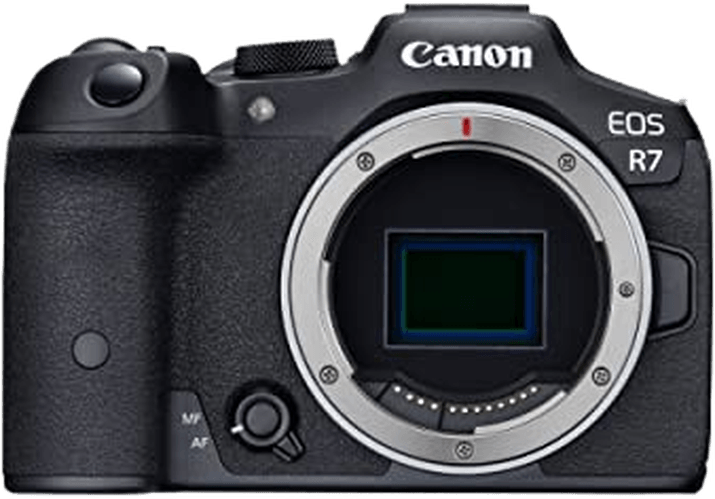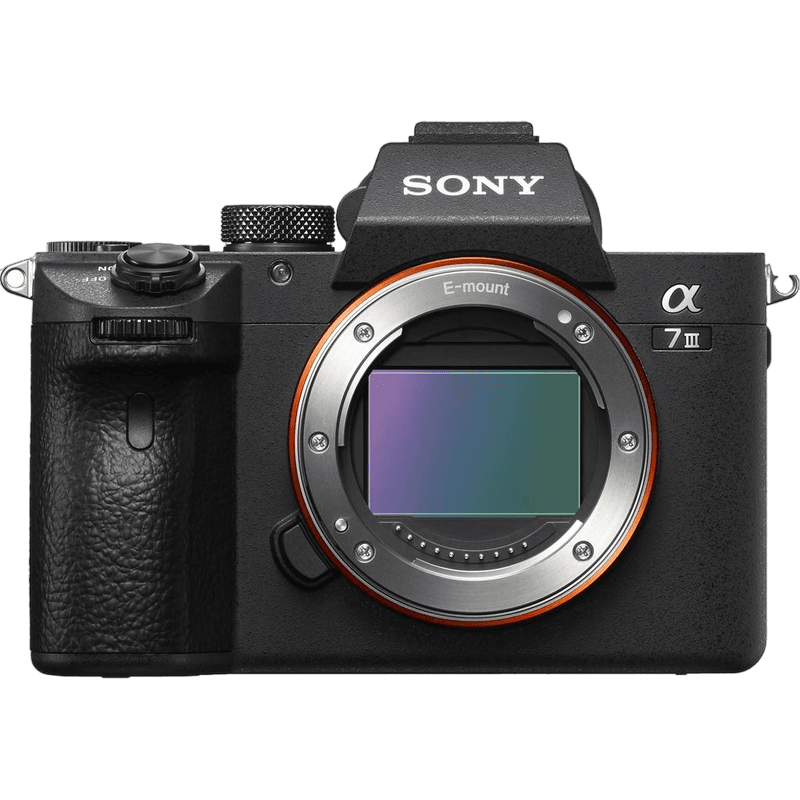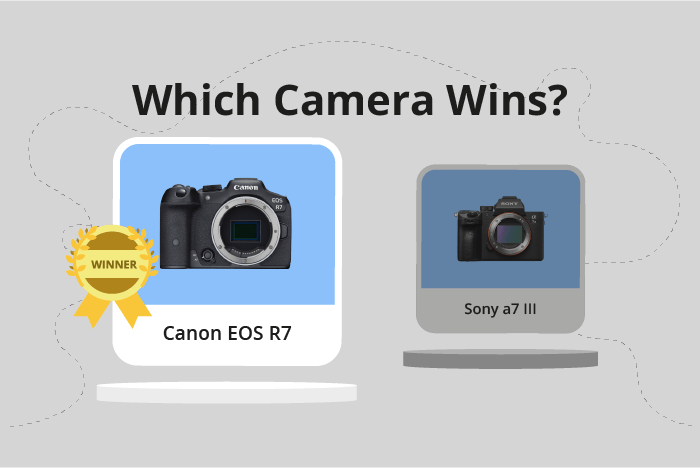Canon EOS R7 vs Sony a7 III Comparison
Canon EOS R7

Sony a7 III

The Canon EOS R7 edges out the Sony a7 III with a score of 83/100 compared to 81. Both are mirrorless cameras with similar dimensions: the EOS R7 measures 132 x 90 x 92mm, while the a7 III is 127 x 96 x 74mm. The EOS R7 is also slightly lighter at 612g versus the a7 III’s 650g.
The Canon EOS R7 outperforms the Sony a7 III with a more recent release year (2022) and a lower launch price of $1500, compared to the a7 III’s 2018 release and $2000 price tag. This makes the EOS R7 more budget-friendly and up-to-date in terms of technology.
The Sony a7 III, however, remains competitive with its smaller and more compact size, which may appeal to photographers who prioritize portability.
Taking these factors into account, the Canon EOS R7 offers better value and newer technology, while the Sony a7 III may be a suitable choice for those seeking a more compact option.
Canon EOS R7 vs Sony a7 III Overview and Optics
The Canon EOS R7 edges out the Sony a7 III in optics, with a score of 82/100 compared to 81/100. Both cameras share several specifications, including a CMOS sensor, image stabilization, and lens mounts designed for their respective brands (Canon RF and Sony FE).
The Canon EOS R7 surpasses the Sony a7 III with its higher megapixel count of 33, allowing for more detailed images. Its shooting speed of 15 frames per second is also faster than the Sony’s 10, providing better performance for capturing fast-moving subjects. Additionally, the EOS R7 has a slightly better DXOMARK score for its sensor, 97 compared to 96, indicating superior image quality.
Despite a lower overall score, the Sony a7 III has its strengths. Its full-frame sensor size is larger than the Canon’s APS-C sensor, resulting in better low-light performance and a shallower depth of field. This can be advantageous for photographers who prioritize those aspects in their work.
Regarding the processors, the Canon EOS R7 features the Digic X processor, while the Sony a7 III uses the Bionz X processor. Both processors contribute to the overall performance and image quality of their respective cameras.
In the end, the Canon EOS R7 slightly outperforms the Sony a7 III in terms of optics, with its higher megapixel count, faster shooting speed, and better sensor DXOMARK score. However, the Sony a7 III’s full-frame sensor size may appeal to photographers who prioritize low-light performance and depth of field. Each camera has its advantages, and the choice between them will depend on individual preferences and shooting needs.
Canon EOS R7 vs Sony a7 III Video Performance
The Canon EOS R7 outperforms the Sony a7 III in video capabilities, scoring 91/100 compared to the Sony’s 70. Both cameras share some common specifications, such as the maximum video resolution of 4K and video dimensions of 3840 x 2160. However, the differences in their capabilities make the Canon EOS R7 the superior choice for video.
The Canon EOS R7 has a significant advantage in its maximum video frame rate, which is 120fps, while the Sony a7 III only offers 30fps. This higher frame rate allows the Canon EOS R7 to capture smoother and more detailed footage, especially in fast-paced or slow-motion scenes.
Taking all of these factors into account, the Canon EOS R7 is the clear winner in terms of video capabilities. Its higher frame rate and built-in time-lapse functionality give users more creative options and better overall performance. While the Sony a7 III may be a suitable choice for photographers who prioritize still images, those looking for exceptional video performance would be better served by the Canon EOS R7.
Canon EOS R7 vs Sony a7 III Features and Benefits
The Canon EOS R7 wins the features comparison with a score of 85/100, while the Sony a7 III scores 81/100. Both cameras share several features, such as a 3-inch screen, touchscreen capabilities, flip screen, lack of GPS, and inclusion of WIFI and Bluetooth.
The Canon EOS R7 outperforms the Sony a7 III in screen resolution, offering 1,620,000 dots compared to the Sony’s 921,600 dots. This higher resolution provides a clearer and sharper display, allowing for better image review and menu navigation.
On the other hand, the Sony a7 III still has strong features, matching the Canon EOS R7 in screen size, touchscreen, flip screen, WIFI, and Bluetooth. While it does not surpass the Canon EOS R7 in any specific area, the Sony a7 III remains a competitive option due to its overall strong feature set.
When considering these cameras, the Canon EOS R7 stands out as the winner in terms of features, mainly due to its superior screen resolution. However, the Sony a7 III remains a viable option for those who prioritize other aspects of a camera, as it matches many of the Canon EOS R7’s features. Ultimately, the choice between these two cameras will depend on individual preferences and specific needs.
Canon EOS R7 vs Sony a7 III Storage and Battery
The Canon EOS R7 and the Sony a7 III score well in storage and battery. Both cameras have two memory card slots and accept SD/SDHC/SDXC cards. However, the Sony a7 III also supports Memory Stick Duo/Pro Duo/Pro-HG Duo cards.
The EOS R7 has a battery life of 660 shots and uses an LP-E6NH battery. It also allows for USB charging. On the other hand, the Sony a7 III has a longer battery life of 750 shots, using an NP-FZ100 battery,.
Alternatives to the Canon EOS R7 and Sony a7 III
Are you still undecided about which camera is right for you? Have a look at these popular comparisons that feature the Canon EOS R7 or the Sony a7 III:

